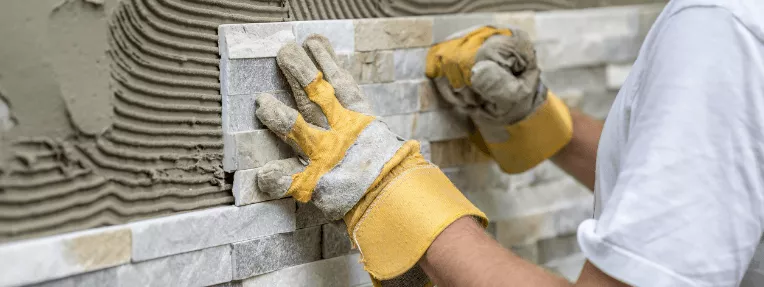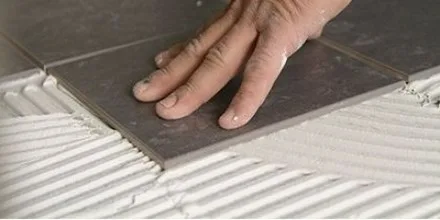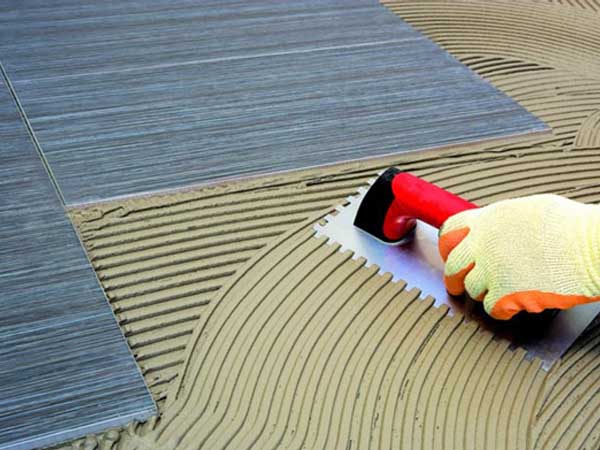Tile adhesives are specialized glues used in the installation of ceramic, porcelain, glass, and natural stone tiles. These adhesives are typically a blend of cement, sand, and polymers that, when mixed with water, create a sticky paste. Their primary function is to securely affix tiles to surfaces like floors, walls, or countertops, providing strong adhesion and even weight distribution for long-lasting and visually appealing tile installations.
What are the importance of tile adhesives?
1. Bonding: Tile adhesives create a strong chemical bond between the tile and the substrate. This bond is essential to ensure that the tiles stay securely in place even when subjected to various stresses, such as foot traffic, heavy loads, or thermal expansion and contraction. The adhesive’s ability to bond effectively prevents tiles from becoming loose or dislodged over time, maintaining the structural integrity of the tiled surface.
2. Load Distribution: Tile adhesives not only bond the tiles but also serve as a load-distributing medium. When weight or loads are applied to the tiled surface, the adhesive evenly spreads and distributes these loads across the entire tiled area. This minimizes the risk of individual tiles cracking or breaking under concentrated pressure points. By distributing the load, the adhesive contributes to the longevity of the tiled surface.
3. Waterproofing: In moisture-prone areas like bathrooms and kitchens, tile adhesives with waterproofing properties are crucial. These adhesives create a moisture-resistant barrier between the tiles and the substrate. This prevents water from infiltrating the substrate, which can lead to structural damage, mold growth, and other issues. The waterproofing aspect of the adhesive enhances the longevity and hygiene of the tiled area.
4. Flexibility: Tile adhesive can accommodate minor movements in the substrate, which can occur due to factors like temperature changes or settling of the building’s foundation. The adhesive’s ability to flex without losing its bond with the tiles reduces the risk of tiles cracking or becoming loose over time, especially in areas prone to structural movements.
5. Durability: Properly applied tile adhesives contribute significantly to the long-term durability of tiled surfaces. They provide a strong and lasting bond, reducing the need for frequent repairs or replacements. The adhesive’s ability to withstand the challenges of daily use and environmental factors adds to the overall longevity and aesthetics of the tiled area.

Different types of tile adhesives
1. Cement-Based Tile Adhesive: Cement-based tile adhesives are composed of Portland cement, sand, and sometimes added modifiers such as polymers. These dry, powdered adhesives require mixing with water to create a slurry that is applied to the substrate. They bond with tiles through a process of hydration and offer high compressive strength, making them suitable for load-bearing applications, especially with tiles having low water absorption rates.

2. Modified Cement-Based Tile Adhesive: Modified cement-based adhesives improve upon the basic cement adhesive by incorporating polymers, latex, or cellulose ethers. These additives enhance flexibility, adhesion strength, and resistance to cracking. As a result, they are ideal for large-format tiles and areas susceptible to slight movement, such as floors with underfloor heating systems, providing versatility and reliability for various tile installations.
3. Epoxy Tile Adhesive: Epoxy adhesives are two-part systems consisting of a resin and a hardener. They are renowned for their exceptional tensile and shear bond strength, making them suitable for non-porous tiles like glass or metal. Epoxy adhesives are characterized by rapid curing, often within 24 hours, making them crucial for projects requiring swift completion, but they demand precise mixing and have a short pot life.

4. Acrylic Tile Adhesive: Acrylic-based adhesives are water-based and contain acrylic polymers. They create a thin, water-resistant film between the tile and substrate, offering good adhesion. Although not as robust as some alternatives, they are well-suited for wall tile applications in moderately moist areas, known for their easy application and extended open time for tile placement.

5. Mastic Tile Adhesive: Mastic adhesives are pre-mixed, organic adhesives with a smooth, paste-like consistency, typically applied with a trowel or notched trowel to create uniform ridges for tile placement. However, they have limitations in load-bearing capacity and water resistance, making them suitable primarily for lightweight wall tiles, like ceramic and glass. Mastic adhesives should be used promptly due to their limited pot life.

6. Organic Tile Adhesive: Organic adhesives are derived from renewable materials such as starch or cellulose. They often have longer curing times due to their organic composition. While offering eco-friendly attributes, they may not provide the same tensile strength as other adhesives, making them suitable for residential applications, particularly natural stone tiles, where sustainability is a priority.

7. Heat-Resistant Tile Adhesive: Heat-resistant adhesives incorporate special binders and aggregates to withstand extreme temperatures without degradation. These adhesives are essential for settings like fireplace surrounds or outdoor installations exposed to high temperatures, ensuring they maintain their bond strength under such conditions.

8. Large-Format Tile Adhesive: Large-format tile adhesives feature specialized formulations with higher polymer content to enhance shear strength and flexibility. They are indispensable when installing heavy, oversized tiles, preventing sagging or tile slippage. The extended open time of these adhesives allows for precise tile alignment during installation, resulting in a flat and even surface.

9. Quick-Setting Tile Adhesive: Quick-setting adhesives utilize rapid-curing cement and chemical accelerators to expedite the installation process. They allow for quicker grouting and the use of the tiled surface, reducing project downtime and proving advantageous when time efficiency is a priority.
How to select the right adhesive for your project?
Selecting the right adhesive for your project involves considering several key factors:
- Materials: Identify the materials you need to bond. Different adhesives work better with specific materials (e.g., wood, metal, plastic).
- Application: Determine the intended use of the adhesive (e.g., structural, temporary, high-temperature) as this affects adhesive choice.
- Bond Strength: Consider the required strength of the bond. Some adhesives provide stronger bonds than others.
- Environmental Conditions: Think about the conditions the adhesive will face, such as temperature, humidity, and exposure to chemicals.
- Cure Time: Decide how quickly you need the adhesive to set and cure. Some adhesives require more time than others.
- Viscosity: Consider the adhesive’s viscosity or thickness. This affects how easy it is to apply and its ability to fill gaps.
- Evaluate your budget and choose an adhesive that fits within it.
- Consultation: Consult with adhesive manufacturers or experts who can recommend the most suitable adhesive for your specific project.
By carefully assessing these factors, you can select the right adhesive for your project, ensuring a strong and durable bond.
Application method for tile adhesives
1. Surface Preparation:
- Ensure the substrate (wall or floor) is clean, dry, and free from dust, grease, and loose particles.
- Repair any cracks or uneven areas in the substrate.
2. Choose the Right Adhesive:
- Select an adhesive suitable for your tile type, substrate, and the location (e.g., indoor or outdoor).
- Read and follow the manufacturer’s instructions on the adhesive packaging.
3. Mixing (if required):
- Some adhesives come premixed, while others need to be prepared. If mixing is necessary, follow the manufacturer’s recommended proportions and use a clean container and mixing tools.
4. Application:
- Use the appropriate notched trowel to apply the adhesive. The size of the notches depends on the tile size and type, so consult the adhesive manufacturer’s guidelines.
- Spread the adhesive evenly on a small section of the substrate.
5. Tile Placement:
- Press the tiles into the adhesive with a slight twisting motion to ensure good contact.
- Use tile spacers to maintain consistent spacing between tiles.
- Check for level and alignment as you go, adjusting the tiles if necessary.
6. Grouting:
- After the adhesive has been set (usually 24 hours or per manufacturer’s instructions), you can proceed to grouting.
- Prepare the grout according to the manufacturer’s instructions.
- Fill the gaps between the tiles with grout using a rubber float, ensuring the joints are completely filled.
7. Grout Cleanup:
- Allow the grout to set for a short time, typically 15-30 minutes, then clean excess grout from the tile surfaces with a damp sponge or cloth.
8. Sealing (if needed):
- Depending on the type of tile and grout used, you may need to apply a sealer to protect the grout and tile surfaces. Follow the sealer manufacturer’s instructions.
9. Final Inspection:
- After the adhesive and grout have cured, inspect the tiled surface for any imperfections, and make any necessary touch-ups or repairs.
Always follow the specific instructions provided by the adhesive and grout manufacturers, as there may be variations in mixing ratios and drying times depending on the product used.
Applications of tile adhesives
- Flooring installation
- Wall tile fixation
- Backsplash tiling
- Shower and wet area installation
- Countertop tiling
- Swimming pool tiling
- Exterior cladding
- Mosaics and artistic tile work
- Commercial and residential new installation & renovation
- Factory walls etc.
Conclusion
Tile adhesives play an important role in ensuring the durability, aesthetics, and functionality of tiled surfaces. With the right choice of tile adhesive, you can achieve beautiful, resilient tile installations that enhance residential, commercial, or industrial facilities. In an upcoming article we will focus on each type of tile adhesives.

